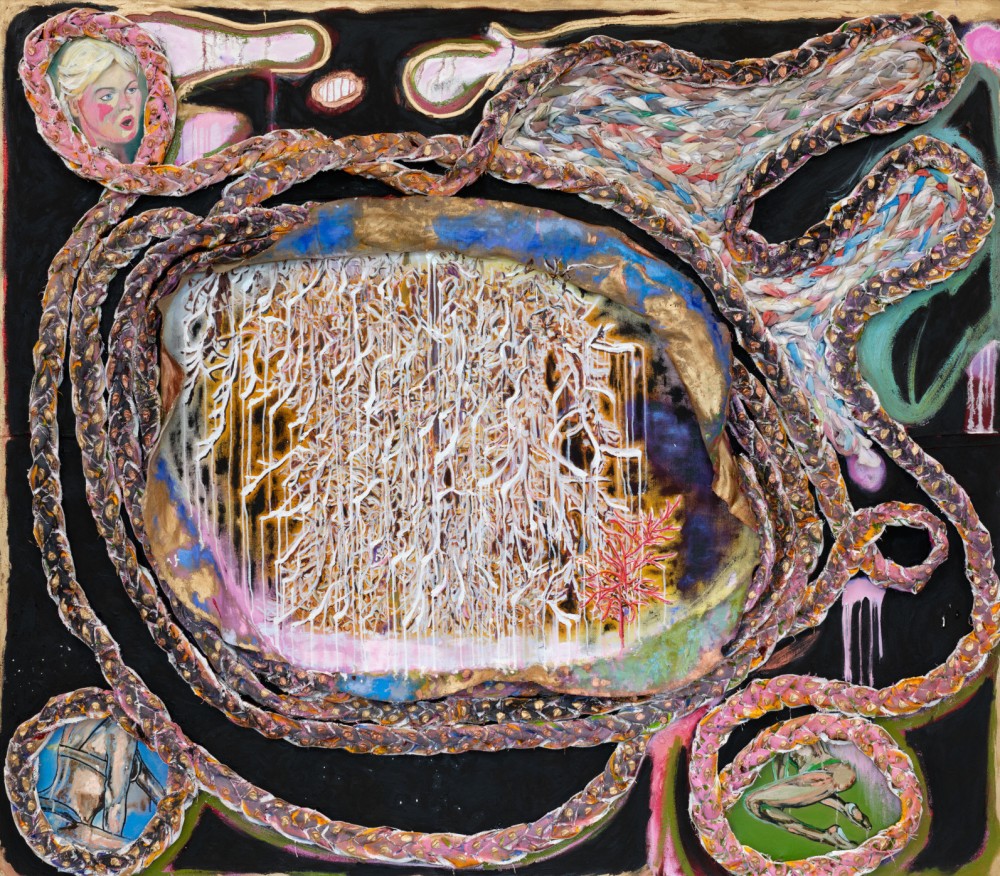
ELAINE STOCKI Wild Braid
Dear Elaine,
After lots of chaos these last few weeks, today I have finally had an afternoon to look and think and write down some of that. And I was thinking about Hoarfrost, and what an odd word it is, and then I found that you had previously used this title in a show of your photographic work.
Then I felt sort of dumb for not asking you about the arrival of “figuration” in your paintings in light of your work with hand tinting and painting in photography, as though what were really at work here was a kind of inversion of already deeply studied terrain rather than the surprise appearance of figures in your studiously non-figurative painting practice. Though perhaps the alternation of surprise and study rather than their opposition is a truer description of the lifeworld of your work.
I woke up this morning thinking about these strange figures alighting on the surfaces of what seemed to me to be otherwise rigorously process based, anti-illusionistic paintings. I suppose the butterfly metaphor stuck with me even though you kind of erased the butterflies from Rorschach, or they became drop shadows of themselves. And I was trying to square this - honestly, with part of our discussion that touched on the loss of your dog, whose name I may not even have had the presence of mind to ask (a shortcoming which I have recalled with a wave of regret several times since we met). We were talking about the deep knowingness of the eyes of our animal friends, and I was remembering that my neighbor’s dog, Mikey, who has often stayed with us, had just that morning given me a surprisingly avowed love gaze, and that this corresponded with a profound emotional shock which I had just endured at the near loss of my father, a shock that was still reverberating as we sat in your studio, and I think we shared in that moment a sense of how the vulnerability of loss is also a kind of opening onto something in the deepest ways of our knowing. I think it was The Knowing Hare that triggered this sudden awareness that many of the figures in your paintings seemed to be looking back, or at least that eyes in some sense calibrated their presence despite the meticulously diagrammatic qualities of your compositions which propose to freeze them into emblematic order. I remembered Bachelard - by way of d’Annunzio - for whom the eye of the hare pausing in the morning frost to gaze out at the horizon became the emblem of his phenomenology of space, what he called intimate immensity, but if your work were to have its own phenomenology of space it would surely invert these terms. The hare would not be gazing at the sublimity of distance, but back in some sense at the viewer.
Does this get me finally to a question about Hoarfrost, or, importantly, Sweet Valley Hoarfrost, and I hope to the wilderness of your braid? I’m thinking of course of the autobiographical dimension of calling on the Sweet Valley mytheme, the anthropomorphisms of Hoarfrost despite the crystalline logic of its wonder work, and that peculiar resolution with which you have braided your way out of the stagnant inlets of what some people call “the discourse of painting.”
— Edward Sterrett
Elaine Stocki (b. 1979, Winnipeg, Canada) holds degrees in both Chemistry and Fine Art from the University of Manitoba and an MFA from Yale University. She has exhibited at Nicelle Beauchene Gallery, New York, NY; Night Gallery, Los Angeles, CA; Thomas Erben Gallery, New York, NY; the Philadelphia Museum of Art, PA; Deutsche Guggenheim, Berlin, Germany; and the Art Gallery of Ontario (AGO), Toronto, Canada among others. Her work has been reviewed in the New York Times, The New Yorker, and Border Crossings Magazine. In 2019, Stocki's first monograph was published by SKIRA Paris on the occasion of a ten year survey of her work at the Canadian Cultural Centre, Paris. Her work is included in the permanent collections of the Los Angeles County Museum of Art (LACMA) and the Philadelphia Museum of Art. Stocki lives and works in Los Angeles.